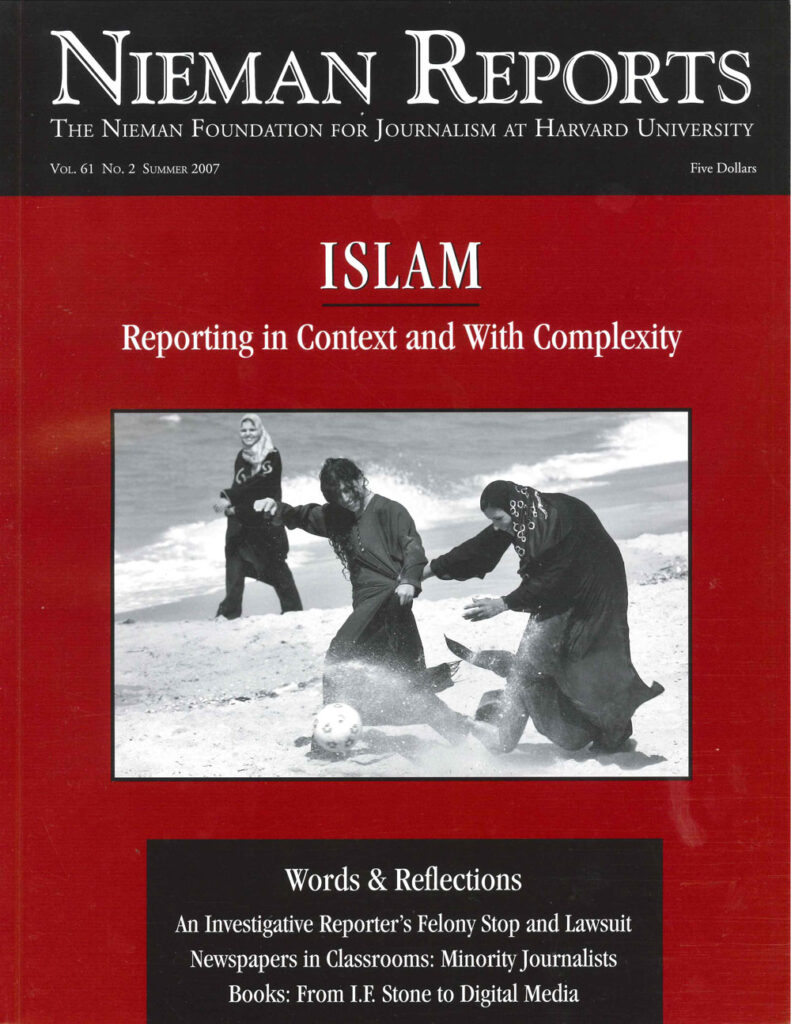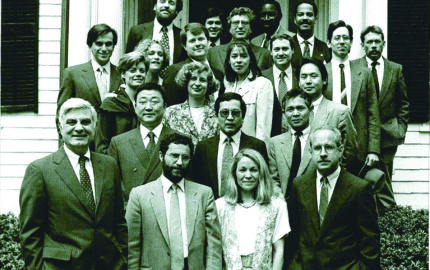Amid concern about the credibility of the press and the future of the printed newspaper, fairness continues to resonate as an important journalistic value. The Nieman Foundation recently recognized three newspapers for "exemplary examples of fairness." Each of the entries presented stories that dealt with different dimensions of fairness. Together, they demonstrate the complexity of fairness in journalism.
The Lancaster New Era received the Taylor Family Award for Fairness in Newspapers and the $10,000 honorarium for its coverage of the Amish school shootings in that rural Pennsylvania community. The newspaper confronted the deeply held spirit of Amish communal life that no individual should stand out from the group. This posed a fundamental issue of fairness for the New Era newsroom: How could the paper balance the community's expectation of immunity—that is, no one would be quoted by name—with its own need to put sources on the record as a matter of journalistic credibility?
The solution, editor Ernest Schreiber explained, was to gather "so much information from so many sources that we could write confidently and compellingly without revealing the identities of those who wished anonymity." The result was a three-day series called "Lost Angels: The untold stories of the Amish school shootings," which shed light on a world usually hidden from view in remarkably fair and just ways.
Reporter Tim Golden was honored for his stories on Guantanamo in The New York Times. In this case, Golden addressed difficult questions about the Bush administration's terrorist-detention system, hidden under layers of government secrecy, and discovered new answers by getting key players to speak on the record about how the system was created and how it has operated. His stories demonstrated that the obstacles to fully informing the public constructed by military or government rationale, even during time of war, should be no substitute for either truth or fairness.
Transparency was the critical element of fairness in reporter John Mangels' series of stories in The (Cleveland) Plain Dealer on a leading scientist in the field of plagues who could not explain the disappearance of 30 vials of plague bacteria from his laboratory and eventually spent two years in prison. Mangels' stories avoided the temptation to characterize the government's role, in the name of homeland security, as one that resulted in an injustice or to portray the scientist as a heroic figure. Mangels achieved transparency, in part, by assembling a long list of footnotes that identified documents and sources for the major points in the series, which he posted online.
The complexity of fairness can be seen in these three examples: respecting cultural and religious traditions to the extent of publishing anonymous quotes; unraveling a failed terrorist-detention program by getting participants to speak on the record, and extensively footnoting sources and documents to help readers understand the reporter's trail.
The Nieman Foundation began the annual recognition of fairness in newspapers in 2002 with support from the Taylor family that owned and published The Boston Globe for five generations. This competition is grounded in the belief that fairness is important to public perception of newspaper credibility; a newspaper that is judged to be fair is also likely to be seen as credible. Newspapers that meet the test of fairness can reassure the public of the important role of the press as a vital institution of democracy.
Following the award ceremony, reporters and editors from the papers being honored talk with Nieman Fellows. Year after year, these discussions reveal qualities distinctive to fair stories that find their foundation in the basic elements of journalism. One of the lessons these discussions yield is that ordinary citizens experienced fairness in many of the stories. The manner in which newspapers reported on the conflicts and tragedies confronting people thrust unexpectedly into the news was often the quality that distinguished the stories as outstanding examples of fairness.
Typically, the reporters gave extensive attention to accuracy and precise detail. They reflected the entire community fully and fairly, and their stories were attuned to cultural differences and nuances. Their reporting revealed an authoritative understanding of the complicated events they were explaining, which resulted in stories that portrayed an accurate context. The reporters seemed to come at the assignment with no preconceived story line. They drew on sources who were in a position to know something about the events being reported on. They used their narrative skills to craft stories that achieved what can be considered an "objective truth."
The journalists who help us each year select the newspapers to be honored find reassurance in the entries they read. They find evidence that reaffirms how newspapers can make fairness a routine part of the daily work of covering the news in a manner that addresses concerns of readers about the fairness and credibility of newspapers.
The Lancaster New Era received the Taylor Family Award for Fairness in Newspapers and the $10,000 honorarium for its coverage of the Amish school shootings in that rural Pennsylvania community. The newspaper confronted the deeply held spirit of Amish communal life that no individual should stand out from the group. This posed a fundamental issue of fairness for the New Era newsroom: How could the paper balance the community's expectation of immunity—that is, no one would be quoted by name—with its own need to put sources on the record as a matter of journalistic credibility?
The solution, editor Ernest Schreiber explained, was to gather "so much information from so many sources that we could write confidently and compellingly without revealing the identities of those who wished anonymity." The result was a three-day series called "Lost Angels: The untold stories of the Amish school shootings," which shed light on a world usually hidden from view in remarkably fair and just ways.
Reporter Tim Golden was honored for his stories on Guantanamo in The New York Times. In this case, Golden addressed difficult questions about the Bush administration's terrorist-detention system, hidden under layers of government secrecy, and discovered new answers by getting key players to speak on the record about how the system was created and how it has operated. His stories demonstrated that the obstacles to fully informing the public constructed by military or government rationale, even during time of war, should be no substitute for either truth or fairness.
Transparency was the critical element of fairness in reporter John Mangels' series of stories in The (Cleveland) Plain Dealer on a leading scientist in the field of plagues who could not explain the disappearance of 30 vials of plague bacteria from his laboratory and eventually spent two years in prison. Mangels' stories avoided the temptation to characterize the government's role, in the name of homeland security, as one that resulted in an injustice or to portray the scientist as a heroic figure. Mangels achieved transparency, in part, by assembling a long list of footnotes that identified documents and sources for the major points in the series, which he posted online.
The complexity of fairness can be seen in these three examples: respecting cultural and religious traditions to the extent of publishing anonymous quotes; unraveling a failed terrorist-detention program by getting participants to speak on the record, and extensively footnoting sources and documents to help readers understand the reporter's trail.
The Nieman Foundation began the annual recognition of fairness in newspapers in 2002 with support from the Taylor family that owned and published The Boston Globe for five generations. This competition is grounded in the belief that fairness is important to public perception of newspaper credibility; a newspaper that is judged to be fair is also likely to be seen as credible. Newspapers that meet the test of fairness can reassure the public of the important role of the press as a vital institution of democracy.
Following the award ceremony, reporters and editors from the papers being honored talk with Nieman Fellows. Year after year, these discussions reveal qualities distinctive to fair stories that find their foundation in the basic elements of journalism. One of the lessons these discussions yield is that ordinary citizens experienced fairness in many of the stories. The manner in which newspapers reported on the conflicts and tragedies confronting people thrust unexpectedly into the news was often the quality that distinguished the stories as outstanding examples of fairness.
Typically, the reporters gave extensive attention to accuracy and precise detail. They reflected the entire community fully and fairly, and their stories were attuned to cultural differences and nuances. Their reporting revealed an authoritative understanding of the complicated events they were explaining, which resulted in stories that portrayed an accurate context. The reporters seemed to come at the assignment with no preconceived story line. They drew on sources who were in a position to know something about the events being reported on. They used their narrative skills to craft stories that achieved what can be considered an "objective truth."
The journalists who help us each year select the newspapers to be honored find reassurance in the entries they read. They find evidence that reaffirms how newspapers can make fairness a routine part of the daily work of covering the news in a manner that addresses concerns of readers about the fairness and credibility of newspapers.



